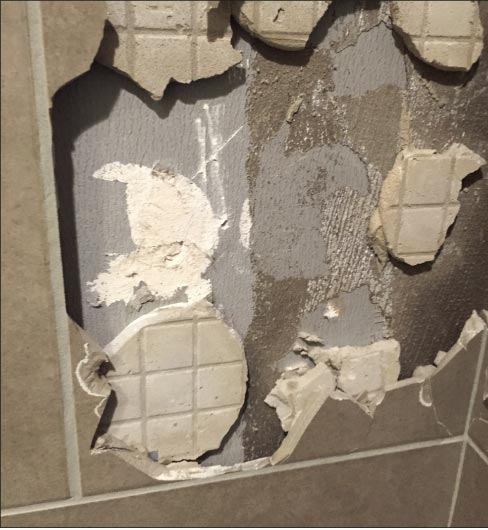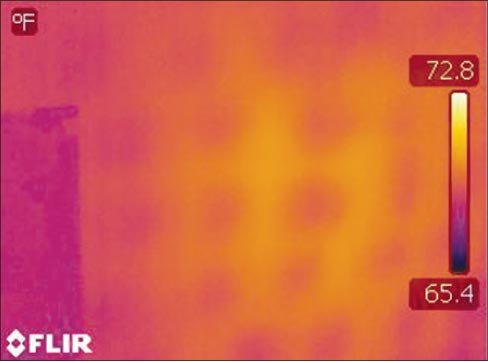The Stone Detective: How I Got My X-Ray Vision
Frederick M. Hueston, PhD
I knew it was going to be one of those days. I had just woken up and was headed out the door to my favorite greasy spoon when I felt something hit my shoulder. At first I thought it was an acorn, but when I looked, it was a present from a bird. Yep, you guessed it: a tweety bomb right on my favorite trench coat.
Oh boy, what a way to start the day, I thought. Fortunately, by the end of the day, I would discover something that would truly help me in my inspection business, but at this point, I thought my day would be like the mess on my coat.
I changed to a cleaner trench coat ( I have a few, to maintain my image), hopped in the ole Woody and headed downtown for the consolation a good cup of joe and a Danish would provide.
Just as I was finishing my Danish (great timing), my phone rang. It was an architect from a large firm in NYC. He told me he had a hotel that his firm had designed. There were over 300 rooms, and the tile in the showers had some type of mysterious film on it. I asked him how old the showers were, figuring it was probably just soap scum. He told me they were brand new and had not been used yet. Well, that got my curiosity, so I told him I could catch a flight the next day and be there in the early afternoon to take a look. He asked me to email him my fees and he would get back to me. Once he saw my fees I figured I would never get a call back. To my surprise, within the hour he called me back and asked me to book a flight. He would meet me at the hotel tomorrow.
 |
|
Mortar dots? This lame time-saver is a bad idea. Just say no. |
 |
|
A thermal imaging camera is a great new tool I recently added to my forensic stone investigation kit. Saves time, gives me a non-destructive option – I call it a win-win. And yes, there’s an app for that. |
The next morning I arrived at the airport. Boy, do I miss the days when flying was fun and an adventure. Today flying is like taking the bus. They crowd you into this tight little row of seats like they are hauling cattle. I took my seat against the window, rolled up my trench coat to use as a pillow and went to sleep.
I arrived in NYC early in the morning and took a cab to the hotel with the tile problem. To my surprise it was still under construction. Hope they have a spare hard hat, I thought, since I didn’t bring mine. There was a guard at the entrance sitting at one of those cheap fold-up card tables. He asked if he could help me. I was about to tell him, yes, get me out of the city…but he didn’t look like he could take a joke.
I told him who I was and he gave me a badge and pointed in a direction to the left of him. Just as I said thank you, a slight, short gentleman dressed in a suit greeted me. He identified himself as the architect I talked to on the phone. He handed me a stack of papers, which appeared to be specifications, emails, safety data sheets, etc., and led me to the elevators.
He took me to one of the completed rooms and I walked into the shower. There was indeed a thin film all over the tile. It looked like nothing more than a grout film. An easy fix, I thought. Next, I started tapping on the tile and holy cow – it was hollow everywhere I tapped!
I looked at the architect and told him he had a bigger problem than the film. He looked surprised and said “Whaaat?” in a nasal Brooklyn accent. I told him what the hollow sounds meant, and one of the tiles actually fell off the wall!
I picked up the tile and noted it had no bond. Not only did it have no bond, but it was installed with mortar dots, as opposed to a full mortar bed (see my photo).
He asked me if there was any way I could tell if the rest of the rooms had the same problem. I told him I could sound-test the rest of them by tapping. He looked at me and asked if there was any other “sure-fire” way to tell.
Just as I was about to answer him, a gentleman walked in with a camera and started taking pictures of the outside wall in the bedroom. The first thing I noticed was that it wasn’t an ordinary camera. It was a thermal camera. Apparently, he was checking for leaks in the wall. I walked over to him and asked him if he could look at the shower. I told him that I was looking for dots behind the tile. He told me he had done this before and we would need to heat the tile with a hair dryer. He explained that the temperature would be different where the spots are.
So, we heated the tiles and he was right. Take a look at the second photo and you can clearly see the dots. I told the architect that we could use thermal imaging for the remaining showers. This would be a non-destructive test to determine if the dot method was used throughout the project. By the way, the dot or spot method is not an acceptable industry practice and is frowned upon by seasoned installers.
Can you guess what the Stone Detective bought when he returned home? Now I can do thermal imaging on installations without doing a destructive test. Even an old man like me can learn something new.
The Stone Detective is a fictional character created by Dr. Frederick M. Hueston, PhD, written to be entertaining and educational. Dr. Fred has written over 33 books on stone and tile installations, fabrication and restoration and also serves as an expert for many legal cases across the world. Send your comments to him at fhueston@stoneforensics.com.